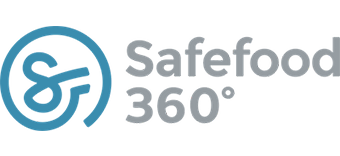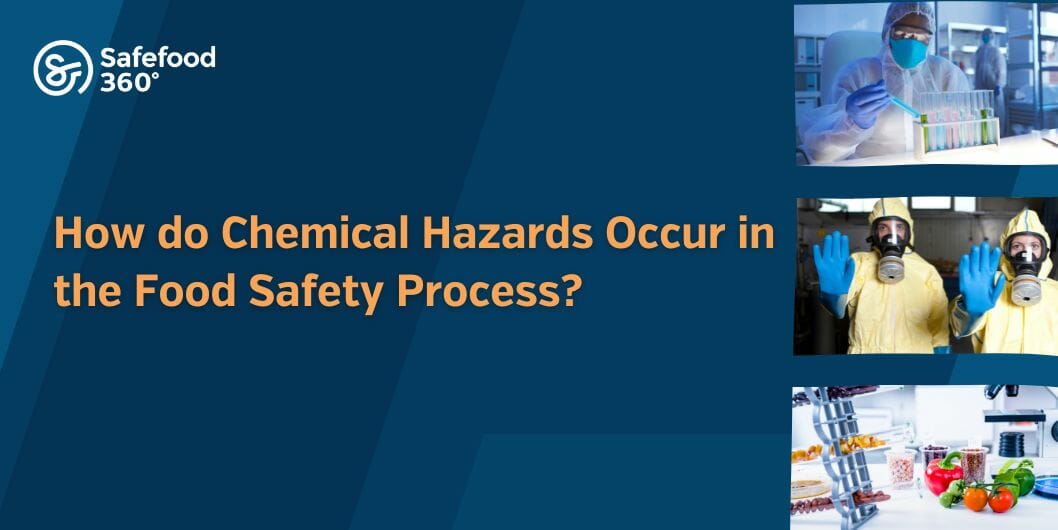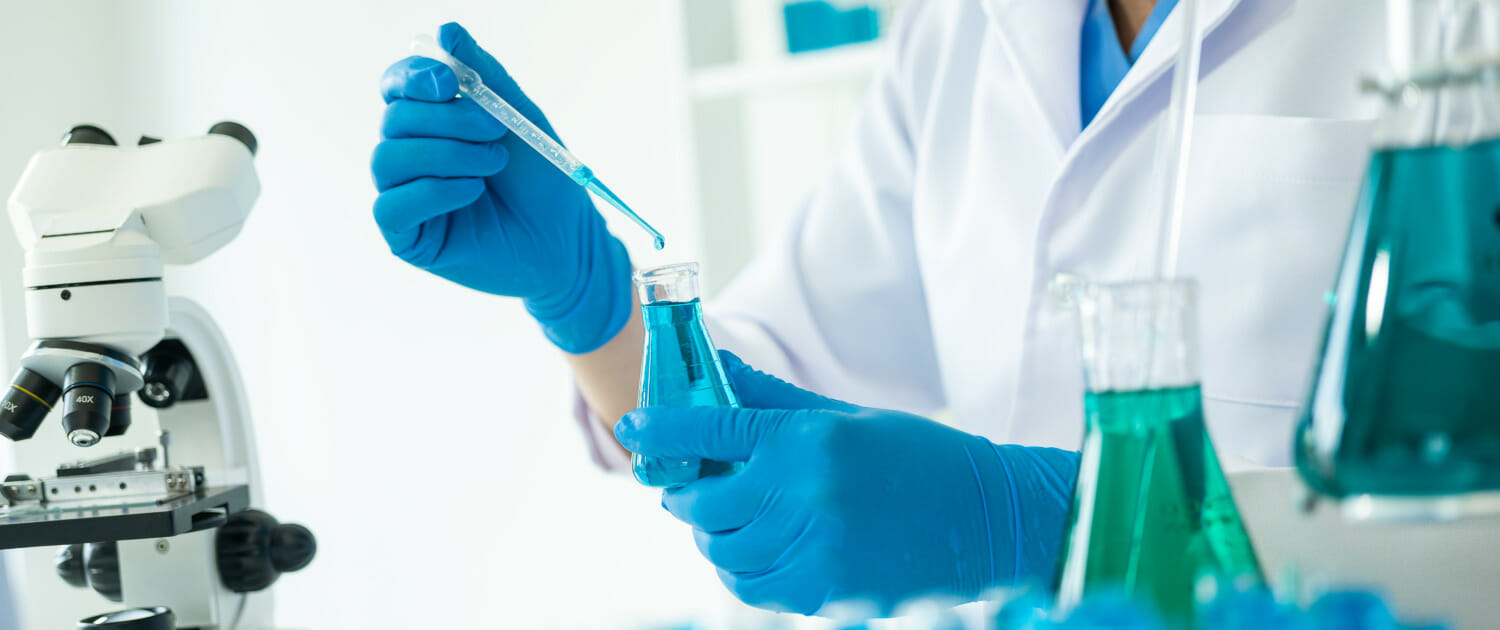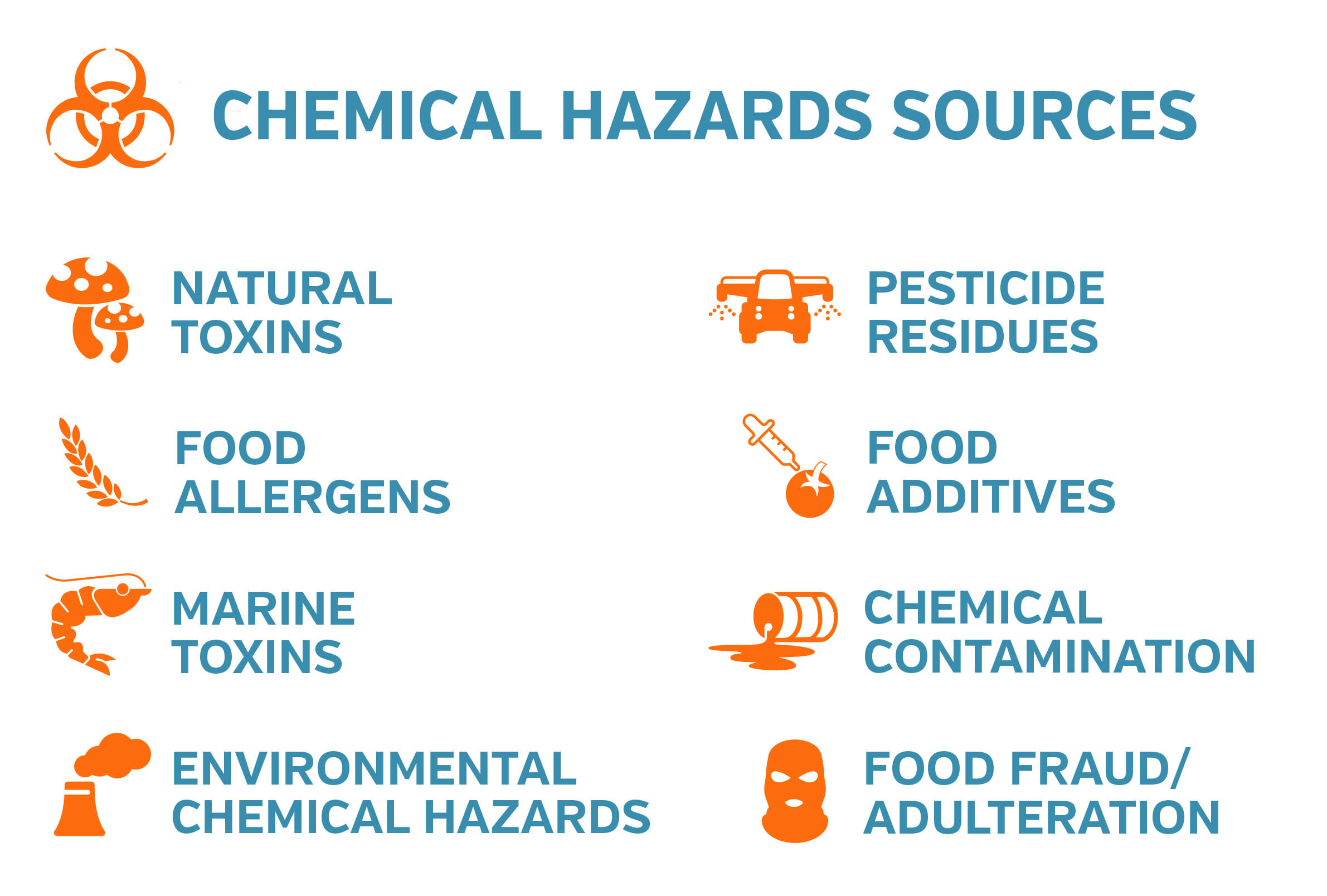How do Chemical Hazards occur in the Food Safety Process?
A chemical substance can be natural or synthetic. Chemicals can be intrinsic to the food product and can play an important role in food production such as being added for taste and preservation reasons e.g., sodium nitrates. Chemical hazards can also occur in food when they are unintentionally added which causes contamination e.g., pesticide residue. Chemical hazards are associated with a high number of food safety alerts, recall and withdrawals. Chemically contained food can cause immediate health effects on consumers or they may have long-term effects depending on the how long they have been exposed. In August 2021 multiple products were recalled due to the presence of the chemical ethylene oxide, a pesticide which is not permitted in the European Union (EU). Products part of the recall included ice-cream and it was the additive locust bean gum which was contaminated with the pesticide.
It is important for Food Safety Plan/HACCP plan team members to understand chemical hazards. The team should know the main categories of chemical hazards associated with food and the toxicology of these hazards. This information can then be used to assist in the development of more robust and informed Food Safety plan.
To gain a fundamental understanding of hazards, you can refer to our earlier article: Food Safety Hazard 101
How do Chemical Hazards occur in Different Types of Food Products?
Chemical hazards can occur in products in several ways such as they may be naturally occurring, used as part of product formulation, or unintentionally present and can then therefore affect the safety of a product. Toxins for example, are naturally occurring chemical hazards that are produced by animals, plants, and microorganisms. Mycotoxins are specifically produced by fungi/mould and pose as a health threat to humans. Moulds which can produce mycotoxins can grow on food such as dried fruit, nuts, cereals, coffee beans, etc. and most are chemically stable and survive prolonged heat processing and can grow due in inadequate storage. As they are naturally occurring, they can’t be fully avoided. Mycotoxin is an umbrella term and there are hundreds of different mycotoxins having been identified such as aflatoxins. Aflatoxins are produced by species of Aspergillus called aspergillus flavus and aspergillus parasitcus. Aflatoxins are known to be one of the most dangerous natural poisons and are highly toxic and a known human carcinogen associated with increased risk of liver cancer. They occur in foods such as peanuts, tree nuts, rice, corn, animal feed etc. People can be exposed to aflatoxins by eating contaminated plant products like peanuts or by consuming products like meat or dairy products from animals that ate contaminated feed. Even farm workers could by accident inhale dust raised during the moving of contaminated feeds. In March 2023 a recall on various brands of popcorn kernels sold in Ireland took place due to elevated levels of aflatoxin in the popcorn kernel’s originating in Turkey. Other examples of the many mycotoxins include: Ochratoxins such as Ochratoxin A found in vine fruits such as currants, raisins, and sultanas. Patulin is produced by a variety of moulds, and is found in apple products and mouldy fruits, grains, and other foods.
How are Food Allergens and Marine Toxins Categorised as Chemical Hazards?
Food allergens should be considered under the chemical hazard category. Under Title 21 of the Code of Federal Regulations specifically section 117.130(b)(1)(ii) details requirements on conducting a hazard analysis to help identify known or foreseeable hazards. Specifically, when it comes to chemical hazards it details identifying natural toxins, residues such as pesticides residue, unapproved additives, radiological hazards, etc. but also states food allergens under the chemical category. Undeclared food allergens are one of the top 3 causes of recalls in the USA in 2022 and are a serious health hazard to consumers allergic to the common food allergens e.g. nuts.
What are Marine Biotoxins and How do They Occur?
Marine toxins found in fish and shellfish can cause foodborne intoxication when consumed by humans. These toxins found in seafood which cause poisoning to humans include amnesic shellfish toxin, diarrhoetic shellfish toxin, neurotoxic shellfish toxin, paralytic shellfish toxin, ciguatoxin and histamine. The toxins generally come from algae that the fish/shellfish feed on or from bacteria naturally present in some fish. Scombroid fish poisoning is an illness caused by consuming fish containing high levels of histamine. In 2021 a number of people in Sweden fell ill with histamine poisoning after consuming tuna in restaurant which originated in Vietnam. In the case of histamine poisoning the toxin occurs due to mishandling of the fish such as storing it at incorrect temperatures. Cooking/freezing of fish does not remove the toxins.
Natural toxins can be produced by plants e.g., glycoalkaloids in potatoes, lectins in beans such as green beans, cyanogenic glycosides in apricot seed and flaxseeds, muscarine in some wild mushrooms.
To further understand each type of chemical hazard, you can download our technical datasheet about Chemical Hazards in the food industry.
What are the Various Sources and Types of Chemical Hazards in Food Production?
Chemicals are often intentionally added to products as they are required for purposes such as preservatives, e.g., nitrates and sulphites in meats or they are used for colouring in the product e.g., cochineal and tartrazine etc. These are chemicals that are deliberately added but could be an issue if high levels are added. Chemical hazards can be produced during the processing of a product e.g., acrylamide, benzene, chloropropanols, furan hydrocarbons etc, and they can form as a result of processing the food under certain conditions relating to high temperature, chemical interaction between ingredients and packaging.
Environmental chemical hazards such as dioxins, polychlorinated bipehentyls, heavy metals such as arsenic, cadium, lead, mercury etc., (You can download our technical datasheet to more specific chemical hazard to know more about that)can also cause illness when consumed through food. Arsenic is commonly associated with rice and while it is present in food in low amounts it is the long-term ingestion of inorganic arsenic and high levels of it that cause health issues. In 2021 a recall took place in the USA due to elevated levels of arsenic in rice cereal for babies.
Chemicals residues from agricultural chemicals used in farming e.g., pesticides, herbicides, fertilisers, fungicide etc., and can make their way through the food chain into food products. In 2020 a number of recalls took place in Europe on bagels, crackers, sesame oil, among the few products, due elevated level of Ethylene oxide in Sesame Seeds originating in India. Ethylene oxide a pesticide which is classed as a mutagen, carcinogen, and reproductive toxicant by the European Chemicals Agency (ECHA). It has been banned in the EU since 1981. Ethylene oxide does not pose a significant risk in small quantities however, there is an increased risk if foods containing the chemical are eaten over long periods of time. Veterinary drugs are used to control and prevent illnesses in animals, e.g., antibiotics. Residues of these drugs can potentially be found in food products above the required limits.
During food production chemical contamination can occur when food comes into contact with a surface that has been cleaned with a cleaning agent but not rinsed correctly. Oils and lubricants used in the maintenance of food processing equipment can also potentially contaminate food due to adequate use or inadequate cleaning.
Chemicals could be added to food intentionally to cause harm i.e., a food crime or adulteration of a product with a chemical for economically motivated reasons. In 2008 melamine was found in milk and infant formula. The melamine was used to give the diluted milk the appearance of containing higher protein content. The addition of the melamine caused kidney issues in children and even some babies died.
What Measures can be Put in Place to Control Chemical Hazards in Food Production?
Clearly, there are many ways chemical toxins can enter our food but what measures can be put in place to stop and/or reduce this happening? Firstly, the control measures will be determined by the specific chemical hazards identified in a hazard analysis.
Before ingredients arrive to a manufacturing facility, control should begin in the field to reduce chemical hazard contamination and a number of measures can be put in place for example Good Agricultural Practice (GAP) measures. The measures are there for number of reasons including safe food production. For example, use of antibiotics/hormones can be minimised and not feeding certain animals by-products to livestock and of course in different regions there is local policies/regulations in place. Facilities need to prevent/reduce chemical hazards in the facility by establishing an effective chemical control program. The facility should identify all potential chemical hazards (this is the purpose of a HACCP of course) such as the chemicals mentioned previously and put in place controls where required e.g., if one of your ingredients is nuts then aflatoxin would be a hazard to identify. When it comes to a manufacturing facility buying in ingredients, they can take steps to ensure what they are buying is compliant with regulation. Food manufacturing facilities should have a supplier approval process to assess and approve suppliers and ingredients, and part of this is requesting documentation such any GFSI certs, letters of guarantee, organic certs etc. and by requesting Certs of Analysis (COA) for ingredients allows verification that certain chemical hazard levels are within regulatory limits e.g., heavy metals such as arsenic. Collecting information from suppliers on the ingredients they supply can help reduce chemical hazards for example if you are purchasing fish, you can study the area the fish was farmed/caught and see if the waters are known to be polluted, as polluted water can lead to heavy metals in fish. An incoming inspection programme for ingredients could include testing e.g., grains incoming to the facilities could be tested for aflatoxin levels, moisture, and water activity to confirm they are within the required levels to ensure no growth of a hazard could occur while stored at the facility. If purchasing ingredients such as fruit and vegetables washing them will reduce residues such as pesticides residues and of course general visual checks on the quality of the fruit and vegetable for example older potatoes maybe be sprouting and sprouting potatoes contain glycoalkaloids as mentioned previously. It’s important to identify if a chemical hazard may be produced/enter the product during the processing of it or even after processing during storage. For example, as mentioned previously cleaning chemical residue could enter a product if there is inadequate cleaning of equipment. To prevent cleaning chemicals/residues in a product, chemicals should be labelled and stored correctly, instructions on using chemicals clearly followed e.g., the contact time and temperature etc. Staff should be trained on chemical hazards and how to handle food and chemicals to avoid contamination issues etc. If chemical additives are added to products for preservation purposes, proper batching procedures should be followed to ensure only the correct amounts are added to product. Verification of batching documentation along with review of recipes with additives should take place to ensure regulations are met. Good storage practices of ingredients and finished products should be in place for example mycotoxins, as mentioned previously, can occur in grains if moisture levels are not controlled or in seafood scrombotoxin can occur if not stored at the correct temperatures. Some chemical hazards become an issue when they are found in food over the established legal limits and different countries will have requirements and limits. Chemical testing plays a significant role in ensuring food is within required limits. Many chemical toxins are not visible and therefore for testing is important for detection. An allergen management programme will help manage food allergens. For example, having proper hygiene practices/procedures can reduce cross-contamination, proper labelling /storage of materials to reduce accidental contamination and proper labelling procedures for finished products to ensure the correct allergens are identified.
Conclusion
Chemical hazards can come from a variety of sources as mentioned throughout this blog, and this means chemical contamination can occur at any stage in the food chain from farming, slaughtering, processing, cooking, storage, etc. This makes eliminating them challenging but it is critical that food facilities conduct a hazard analysis to ensure that the minimum levels of chemical contaminants end up in the food being produced. At each step in the process chemical hazards should be identified, a risk assessment needs to be completed with justification for determining the severity and likelihood of the hazards, and details on the preventative measures in place need to be developed within the food safety plan. Food safety teams should regularly monitor operations especially those with a significant risk for chemical hazards.
Safefood 360° is an innovative software designed by food experts, and it is dedicated to food manufacturers to work for a safer world. Subscribe to our newsletter for the latest food safety news. If you would like to have more details about how to ensure the food safety of your company, submit a demo request here.







Leave a Reply
Want to join the discussion?Feel free to contribute!